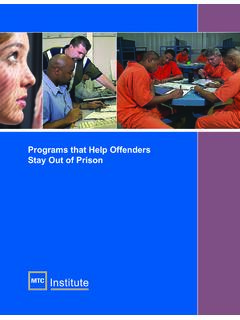Transcription of Women Professionals in Corrections: A Growing …
1 Women Professionals in Corrections: A Growing AssetWomen Professionals in Corrections: A Growing Asset AcknowledgementsThe Institute is grateful to the various MTC corrections staff who provided their input including:Anita Dutson, Sr. Director, MTC Corrections ProgramsDarla Elliott, Warden, Arizona State Prison-Kingman and AWEC Board of DirectorStacy Henry, Director, MTC Corrections ProgramsDeborah Hill, Assistant to the Warden, North Coast Correctional Treatment FacilityJackie Thomas, Warden, North Coast Correctional Treatment Facility, OH and AWEC Board of Director John Vanyur, , Sr. Director, MTC Corrections Marketing and former Warden and Assistant Director, Federal Bureau of CorrectionsWe especially thank the external reviewers who critiqued this document:Debbie Boyer, Corrections Quality Assurance Administrator, Oklahoma Department of CorrectionsToni Brooks, North Regional Director, Ohio Department of Rehabilitation and CorrectionYvonne Doll, , LTC (Ret), Assistant Professor of Military Leadership at the Command and General Staff College, Fort Leavenworth, KansasJohn Gannon, , Executive Director, International Assoc.
2 For Correctional and Forensic PsychologyCindy Goulding, Independent Contractor, Organizational Development SpecialistKimberly Greer, , Associate Professor, Department of Sociology and Corrections, Minnesota State University, MankatoEllen Kirschbaum, Program Manager, Juvenile Justice Services Division, Arizona Supreme CourtBona Miller, former Acting Director (retired), Idaho Dept. of Corrections and past president of AWECJ oann Brown Morton, , Associate Professor, University of Georgia and chairwoman, ACA Women Working in Corrections CommitteeAmanda Newsum, Editorial Advisor, University of Phoenix Francine Perretta, Chief of Probation, St. Lawrence County Probation and President, AWECJudy R. Philpott, Senior Asst Superintendent for Adult Programs, Virginia Dept. of Correctional EducationWilliam J. Sabol, , Chief, Corrections Statistics, Bureau of Justice StatisticsTheir participation has enhanced the value of the information for staff of correctional/detention agencies and facili-ties, parole and probation agencies, policy makers, and elected also extend thanks to the various MTC Executive staff who contributed their understanding and knowledge to the project.
3 Finally, we recognize the valuable guidance and feedback of this project from Roberts T. Jones, President, MTC Institute as well as comments and observations from MTC President & CEO, Scott Marquardt, whose input helped make this document Professionals in corrections: A Growing Asset Published by MTC Institute. Copyright August Author: Carl NinkComments are appreciated and should be directed to Carl Nink, Executive Director at: management & training corporationMTC InstituteAddress: 500 North Marketplace Drive Box 10 Centerville, UT 84014 Telephone: (801) 693-2870 Fax: (801) 693-2900E-mail: & Training Corporation (MTC) is an international corporation dedicated to helping people realize their learning potential. MTC creates nurturing environments in which education is encouraged and recognized. MTC operates 12 contracted correctional facilities across the country with approximately 16,000 beds under contract.
4 MTC also manages and operates 25 Job Corps centers in 18 states for the Department of Labor, preparing disadvantaged youth for meaningful careers. In addition, MTC has expanded their education and vocational expertise into the international arena, working in countries such as Iraq, Sudan, Tunisia, China, and Mongolia. The MTC Institute is the research division of MTC, which is dedicated to promoting innovations, exemplary practices, and projecting trends that are relevant to job training and corrections. The work of the Institute is geared towards a broad audience including policy makers, educators, researchers, practitioners, state and federal officials, workforce development entities, correctional agencies and Job Corps centers. mtc InstItuteTable of ContentsexecutIve summAry ..1 IntroductIon ..3lessons From HIstory ..4eArly HumAn develoPment consIderAtIons.
5 5women In tHe workPlAce ..5creAtIng oPPortunItIes ..5tHe orgAnIzAtIonAl culture Is cHAngIng ..6tHe APProAcH to workIng wItH oFFenders Is cHAngIng ..7gender InFormAtIon And dAtA ..8tHe vAlue tHAt Women BrIng to tHe correctIons ProFessIon ..8 Problem Solving and Decision Making ..8 A Calming Influence Inside Prisons ..8 Leadership ..9 Mentorship and Coaching ..10do Women need gender sPecIFIc trAInIng? ..11women And men tAlkIng on tHe JoB ..13lAck oF resPect From mAle stAFF HAs A negAtIve ImPAct on FemAle stAFF ..13strAtegIes to reduce turnover And ImProve tHe orgAnIzAtIonAl oPerAtIon ..14 InmAte mAnIPulAtIon oF Women workIng In correctIons ..15 BeIng PrePAred For Future oPPortunItIes ..16 Supportive Organization Efforts ..17mentorIng relAtIonsHIPs And networkIng ..17conclusIon ..18 APPendIx A exAmPles oF ProgrAms ..20 APPendIx B demogrAPHIc, gender And correctIonAl Personnel dAtA.
6 21 Growth in Female correction Officers, Supervisors, and Executives ..22 APPendIx c - wHAt Are some oF tHe wArnIng sIgnAls? ..24 Personal Indicators ..24 Operational Indicators ..24 The Victim Profile ..24 APPendIx d - How to eFFectIvely IncorPorAte Women Into tHe correctIons FIeld ..25 Communications ..25 Workcrew Supervision ..25 Searching Inmates ..25 Reduction of Turnover ..25 Shift Assignments ..25 Acquiring Experience ..26 Managing Inmates ..26 APPendIx e professional certIFIcAtIon ProgrAms ..27 APPendIx F - QuArterly trAInIng modules For Women Professionals ..28endnotes ..29 Women Professionals in Corrections: A Growing Asset1mtc InstItuteexecutIve summAryNot only is there a war for talent going on, but a war for talented Women coming into the workforce is underway, especially in the so-called traditionally male workplaces, such as construction, engineer-ing, and corrections.
7 More Women are entering the workforce, bringing their strengths and attributes into formerly male-dominated environments. Those indus-tries not already planning ways to increase hiring of Women are behind other industries; the construction industry, for example, is facing critical shortages and is now looking to Women to fill these ranks. There are construction apprenticeships in the High Schools for young Women , job shadowing, scholarships, and ac-tive recruiting campaigns for It is important that correctional agencies also explore what can be done to increase the number of Women Professionals working in corrections. In the competitive marketplace, organizations must attract, develop, and retain highly qualified talent. Organizations that are effective in this regard recog-nizes, values, and mentors emerging Women leaders. These entities also ensure that Women are encouraged and used throughout the workplace which can lead to improvements in the organizational culture.
8 Further, to advance their careers, Women need opportunities to develop credentials, organizational knowledge, and management competencies. In order to enhance the potential to develop high performing Women , man-agement should use strategies that capitalize on com-municative abilities. Women who occupy correctional leadership roles use their ability to collaborate and inspire others to implement their initiatives as well as reflect on how they impact policy and woman faces many challenges in seeking to move to the next level in an organization and those chal-lenges don t stop after achieving a position of senior leadership. Once in that role, Women must figure out how to gain credibility, trust, and respect as a leader. Frequently, Women feel they have to perform at a level much higher than a male peer to be viewed as Senior leaders also have to create their own style of leadership.
9 This process can be helped by network-ing, having a mentor, and participating in training programs designed to meet their unique needs, thus helping them become prepared to be number of Women in the workforce is projected to grow by percent compared to percent for men through 2014; when Women will comprise 47 percent of the In 2007, over 59 percent or 70 million Women age 16 and over participated in the labor force, compared to 74 percent or 82 million men and the percent of those Women who are employed held steady at percent in 2006 and 2007, whereas the percentage of men employed declined from percent in 2006 to percent in There were about 15,000 Women working as first-line supervisors of correctional officers (29 percent) compared with 37,000 men in 20066 and there is a 13% increase in the number of additional first line super-visory staff projected for corrections between 2006 and Probation officers and Correctional Treat-ment Specialists are also projected to grow, at least 11 percent between 2006 and 20167 or slightly more than 1,000 staff per year, which is about as fast as other the last eight years, the growth of Women work-ing in correctional facilities has been 40 percent based on the information reported to the American Cor-rectional Association, going from 108,913 in 1999 to 152,456 in 2007 (Note: This number takes into account data from seven states posted in 2006 which did not report data in 2007 as well as no data from Connecti-cut and Vermont which did not submit information in either year).
10 9 The workforce numbers and demographics support the fact that Women are currently playing a much larg-er role in the workplace, in general, and in criminal justice specifically, and they will be a more significant human resources asset in the future. Beyond these facts, Women at present are receiving and will con-tinue to receive more college and professional degrees than men. Women represent a large educated talent The number of Women in the workforce is projected to grow by percent compared to percent for men through 2014; with Women comprising 47 percent of the With a 13% workforce increase in the number of additional supervisory staff projected for corrections between 2006 and 201643, Women represent a Growing , educated human resource asset. The Institute, in this public policy paper, looks at this Growing part of the correctional workforce, examining issues affecting Women and their career Professionals in Corrections: A Growing Assetpool which, in times of increasing demand, should be viewed as an excellent source of skilled workers and leaders within the corrections profession.






